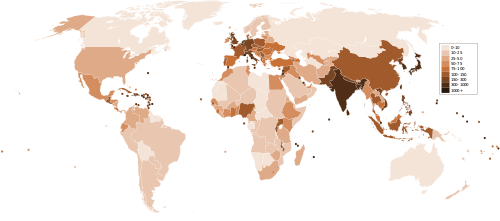Talk:Choropleth map
| This article is rated C-class on Wikipedia's content assessment scale. It is of interest to the following WikiProjects: | |||||||||||||||||||||
| |||||||||||||||||||||
Maps in article[edit]
You should show how a Chloropleth is less accurate than a map that shows density at each point:
It would be better if the maps were on the same scale and projection, color scheme, though. -- [[71.167.62.4| (|71.167.62.4|) on 2009-08-08T19:22:27
- For some definitions of better. It depends on what you are trying to show. For example, with a dot density map you could have several areas with such high population density each of which would be covered with ink, but you could not reliably distinguish between them even if they differed greatly. On a large scale map you could adjust the physical or variable size of your dot, but on a global map this would be difficult without over-representing other areas (or round8ng them into oblivion). --Belg4mit (talk) 23:59, 9 August 2011 (UTC)
Complaint[edit]
THE MAP SHOW IN THE ARTICLE IS NOT EVEN A CHLOROPLETH MAP. OH BROTHER. —Preceding unsigned comment added by 68.122.68.76 (talk) 22:28, 8 February 2010 (UTC)
- More importantly, the map at the top of the page is hideously ugly, incredibly confusing to try to read, and couldn't break more rules of information presentation without deliberately trying to. The biggest problem is that the color progression is in what appears to be a completely nonsensical order, so there's no way to tell what anything even means without constantly referring back to the legend. There must be a more suitable image on here somewhere to use instead. The comparison one farther down the page is much, much better (although that may be the first time I've ever seen "population per acre", rather than "per square mile/km"). 173.48.208.226 (talk) 09:46, 16 August 2011 (UTC)
- Thanks, I made that since we did not have one about normalization. It's acres because of the large scale (that's tiny Cambridge, MA), but I just noticed I left off the scale bar! The horror... I'll have to fix that this weekend. --Belg4mit (talk) 04:46, 17 August 2011 (UTC)
"hideously ugly, incredibly confusing to try to read, and couldn't break more rules of information presentation without deliberately trying to." No kidding. It *IS* trying to. You think anyone uses the term "chloropleth" for any reason OTHER than to try to show they're smarter than you? Bluntly, I think "Linguistic irrelevance" borders on being a legitimate section. 65.27.134.29 (talk) 04:54, 17 March 2012 (UTC)Ubiquitousnewt
- The first complainer doesn't even know the word (it's choropleth, not chloropleth), and the second one doesn't recognize the importance of terminology in a field they're ignorant of. Thnidu (talk) 16:29, 10 September 2013 (UTC)
Partial spectrum[edit]
The description of this scale is awkward and unclear. From what I can make out, you map two-dimensional data onto a single dimension and this is in turn is replaced with color. e.g; two variables 0 to 1, and the progression lies along y=x. Values not on the line are shown with a correeponding value from the line, such as the point where a tangent to the scale intersects the data point? --Belg4mit (talk) 16:10, 10 August 2011 (UTC)
unintelligible fragment[edit]
The section Color progression says in one paragraph:
- Partial spectral hue progressions are used to map mixtures of two distinct sets of data. This type of hue progression will blend two adjacent opponent hues and show the magnitude of the mixing data classes. When the two colors chosen match the solar spectrum that shows the greatest magnitude.
The underlined "sentence" is a meaningless fragment. I'm commenting it out and asking for help in the Maps and Statistics projects. --Thnidu (talk) 16:33, 10 September 2013 (UTC)
- I agree, deleting it doesn't hurt the exposition. The sentence might be referring to this paper by Colin Ware showing that using the "physical spectrum" mitigates errors in reading choropleth maps based on partial spectral hue progression due to simultaneous contrast effects. But that is just a guess. --Mark viking (talk) 19:14, 10 September 2013 (UTC)
colour mapping[edit]
The section "Color progression" does not mention bivariate colour maps. e.g. https://www.joshuastevens.net/cartography/make-a-bivariate-choropleth-map/
Pronunciation?[edit]
There is no pronunciation information on this page like there usually is on wiki pages with uncommon words. How do you say it? (K sound or Ch at the beginning for one) Ansarya (talk) —Preceding undated comment added 14:36, 4 May 2020 (UTC)
202.140.217.85 (talk) 06:24, 22 September 2019 (UTC)
Overhaul[edit]
I have significantly revised this page, including the addition of several figures, more explanation, and a lot of citations. It could still use a couple things, such as:
- more history
- more about issues with choropleth maps, such as MAUP
- a section on legend design
- a diagram visualizing differences in classification (maybe based around a histogram)
- a good example of a bivariate choropleth map.
I have also reset the quality ratings on the WikiProject links on this page, so hopefully someone will re-review it. Bplewe (talk) 00:04, 8 November 2020 (UTC)




